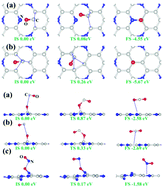Repairing single and double atomic vacancies in a C3N monolayer with CO or NO molecules: a first-principles study†
Abstract
Even the simplest point defect in a two-dimensional (2D) material can have a significant influence on its electronic, magnetic, and chemical properties. Defect repairing in 2D materials has been a focus of concern in recent years. Based on first-principles calculations, the repair of C and N single vacancies with CO or NO molecules in a C3N monolayer has been studied. The repair process consists of two steps, i.e., filling of the vacancy with the first molecule and removal of the extra O atom by a second molecule. Overall, the repair processes of C and N single vacancies by CO or NO molecules are both thermodynamically and kinetically favorable, as evidenced by the significant energy released and the small energy barriers. In addition, the electronic and magnetic properties and the chemical activity of the C3N monolayer before and after the defect repair have been studied systematically. In addition to single vacancies, the repair of double vacancies with CO was also studied; this process is much less kinetically favorable than the case of single vacancies. This study provides useful insight into the effects of simple atomic vacancies on the physical and chemical properties of the C3N 2D semiconductor and also presents a promising strategy for repairing vacancies.



 Please wait while we load your content...
Please wait while we load your content...